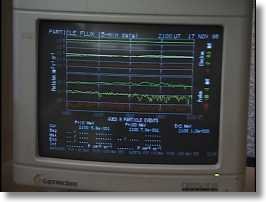|
Z d e n k a S m i t h Research Physicist Space Environment Center, NOAA, Boulder, CO
I continued on with graduate work at Stanford University's Applied Physics Department.
There, I enjoyed most of all learning about the Sun. I received an M.Sc., married, and
started work at NASA's Ames Research Center, in the Plasma probe group. This group was in
charge of the plasma probes on the Pioneer satellites. I was tasked with overseeing the
development of programs to reduce (analyze) the data, and to investigate the recently
discovered temperature anisotropy (non-symmetrical shape) of the solar wind. This led me
to constructing my first numerical model, to determine the details of how the instrument
worked.
After my husband received his Ph.D., we spent a year in Moscow, USSR, before moving to
Boulder CO. Here I was pleased to find work at the Space Environment Laboratory (now
Center). Here I have worked in studies of the Interplanetary medium, first with shocks,
then numerical (time dependent magnetohydrodynamic [MHD]) modeling. First 1 dimensional,
then 2D and 3D as computers got bigger and faster. We used data as input into these
models and compared the output to spacecraft data, to find out how much of the solar wind
behavior can be explained by MHD. I also developed algorithms-small models based on the
results of the large models, for predicting the arrival of solar-initiated interplanetary
disturbances at Earth. Now I am also working on the possibility of using solar wind
high-energy-particles to help forecast the arrival of these disturbances.
What do I do?
One of my present projects is to respond to solar events and make predictions using
two of our models. The particular data we watch are radio signals called "Type II
bursts." When one is reported, or a solar event occurs that we think may be geo-effective
(may affect Earth), I get together, by phone or e-mail, with colleagues, often a
forecaster, to determine the input values. Then I run our models to get a prediction.
These are not "operationally ready" models, but are in testing.
|
